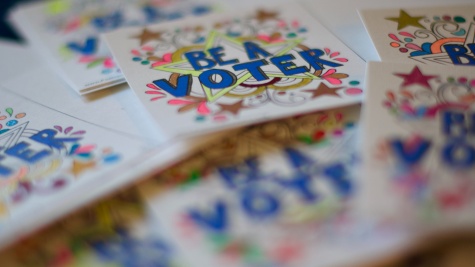A Tale of Two Counties
A Study of Vote Centers in Fresno County and St. Louis County
The MIT Election Data and Science Lab helps highlight new research and interesting ideas in election science, including through research grants under our ongoing Learning from Elections program.
Our post today was written by Anita Manion, Lisa Bryant, and David Kimball, based on their ongoing research funded by this program. The information and opinions expressed in this column represent their own research, and do not necessarily represent the opinions of the MIT Election Lab or MIT.
The COVID-19 pandemic created significant pressure on election officials to reduce the number of polling places. Vote centers are one solution to this problem.
Impetus for the project and goals
We seek to understand the implementation of vote centers in two counties, Fresno County, California, and St. Louis County, Missouri, during the pandemic. These cases offer two very different local contexts in terms of state requirements and oversight. In cooperation with local election officials in those counties, we aim to increase understanding in these areas: (1) voter awareness and evaluation of vote centers (based on public opinion surveys), (2) shifts in polling place locations and local voter turnout after the transition, (3) and lessons learned in terms of staff, technology, and procedures needed for successful implementation.
The two cases for our study are similar in size (with roughly one million in total population), and both first adopted vote centers in 2020. Thus, both counties had to contend with the pandemic while implementing vote centers. However, Fresno is engaged in more of a top-down process of implementation, while St. Louis is more of a bottom-up case. Fresno County, like several other California counties, adopted vote centers in compliance with the state’s Voter Choice Act, which includes clear requirements on voter outreach, locations and accessibility, among other things–a top-down approach to implementation. Meanwhile, St. Louis County is the only county in Missouri to implement vote centers, and did so without any state requirements or guidelines; Missouri law says nothing about vote centers. Thus, St. Louis County is making decisions based on their own expertise and resources–a bottom-up approach.
In our study we will also examine whether or not state guidelines make implementation easier or more difficult for local elections officials, and whether or not it makes a difference in the overall voter experience, or for various demographic groups (e.g., racial/ethnic minorities, low-income, elderly) that may be impacted by the reduction in voting locations. These are important considerations given the increasing number of jurisdictions considering vote centers across the country.
Progress and Preliminary Findings
Our team is taking a number of approaches to gather and analyze the data for this study. We interviewed LEOs in Fresno and St. Louis Counties to determine their implementation strategy and the approaches they take to informing voters about vote centers. We also asked LEOs and their staff about what technology, procedures, and staff need to be in place to make the transition to vote centers successful. Additionally, we are working with Barry Burden, University of Wisconsin-Madison, and Robert Stein, Rice University, on their project to survey poll workers. The survey went out to poll workers in Fresno and St. Louis Counties to get their perspectives about poll worker training, voter experience, and the implementation of vote centers.
We have the results for the pre-election survey of 1,070 poll workers in the two jurisdictions, which indicate an overwhelming support for the vote center model, allowing voters to vote at any polling location (St. Louis 93.5%; Fresno 93.2%). When reflecting on the 2020 election, over 97% of poll workers in Fresno and St. Louis Counties said few or no voters experienced problems when recording their vote choices, checking in to vote with the proper voter identification, or completing a provisional ballot.
One area of divergence between the two jurisdictions was when asked about voters waiting more than an hour to vote. In Fresno, 97.3% said few or no voters waited for more than an hour, but in St. Louis only 75.9% said few or no voters waited for more than an hour to vote. This may be due to the fact that a much higher share of voters cast their ballot in person on Election Day in St. Louis County than in Fresno County. Our collaborations with LEOs in both jurisdictions has been critical to understanding the strategies, successes, and challenges they experienced in implementing vote centers, and they were also an important link in our survey of poll workers.
To better understand voter awareness and evaluation of vote centers, we developed and deployed a survey of registered voters in both jurisdictions, asking questions about the voter experience, knowledge of their ability to vote at any location, recall on education or informational materials received, choice of voting location, attitude toward vote centers, confidence in the election results, and ease of finding information about where to vote. This survey was
distributed following the general election in November 2022 and has garnered more than 1,200 responses (St. Louis County=863, Fresno County=465). (The California registered voter sample was not received until late-December and the survey went into the field on December 27, 2022. Responses are still being collected.)
Our preliminary findings indicate that there were wide disparities in knowledge of the ability to vote at any location, 62% of voters in Fresno County knew they could use any location, compared to only 44% of voters in St. Louis County. (Interestingly, 26% of voters in St. Louis County reported not knowing where they could/should vote, while only 8% of Fresno County voters chose “don’t know.”) Voters in both counties prefer the vote center model; however, those in Fresno County had a higher preference (77%) than those in St. Louis (65%). St. Louis County has more voting locations than Fresno County and 90% of voters in St. Louis reported it as being easy to find their location compared to 71% in Fresno.
There were also differences in voter confidence, wait times (confirming the poll worker responses from the two counties), and perceptions of the occurrence of fraud (with 20% of respondents in Fresno County reporting voter fraud is “very common” compared to only 9% in St. Louis); however, approximately 60% of respondents in both counties reported the vote center model makes elections more secure. To better understand shifts in polling places and affected populations, we have used ArcGIS to map the locations of new versus old polling places. So far, there do not appear to be glaring geographic disparities in the location of closed polling places, but we will be examining this more. Furthermore, we do not find evidence of lower voter turnout after the adoption of vote centers, and in California turnout increased in counties that adopted VCA reforms.
Next Steps
There are additional data and analyses we will utilize in this project. Some of the data we need is not yet available. To determine if there were shifts in local turnout after the transition to vote centers, we will analyze voter files and precinct-level turnout data, which we do not yet have access to. The voter file in Fresno County provides more detailed voter history data, including voting mode and vote center or dropbox locations used by the voter. The voter file in St. Louis County only indicates whether each registrant voted. However, each polling place St. Louis County reports how many ballots were cast by voters assigned to that location and how many ballots were cast by voters from other parts of the county (taking advantage of the vote anywhere feature). Thus, some analyses across the two jurisdictions will vary based on data availability.
In addition, we will analyze precinct-level demographic features (particularly race) and the locations of public transportation stops to better understand the association between race, proximity to transportation hubs, and voter turnout. We are also awaiting results from our post-election poll worker survey. Those results will give us more insight into the poll worker experience in 2022.
We are also eager to see the poll worker survey data from other jurisdictions to would like to compare results from those in counties with vote centers and those without to see if they align with the results in our counties. Additionally, we will work with local election officials to gather and analyze wait time data and conduct a post-election debriefing on the benefits and drawbacks of the vote center model in the 2022 election, including how top-down policies (or lack thereof) helped or hindered their efforts.



